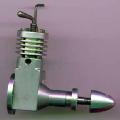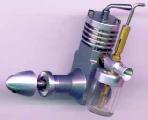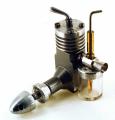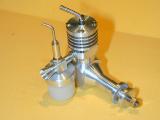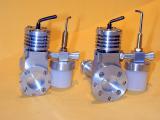M.L. Midge
![]()
| Name | M.L. Midge | Designer | Mark Lubbock |
| Type | compression ignition | Capacity | 0.5 or .8cc |
| Production run | home construction | Country of Origin | UK |
| Photo by | Ken Croft | Year of manufacture | plans published 1997 |
Notes:
The scheme that uses the piston to control timing for inlet, exhaust and transfer is, for some reason, called "side-port", even though most all examples place the inlet at the back. To my mind, the ML Midge is, as the designer asserts, a genuine side-port! The design was serialized in Aviation Modeller International, issues April and June of 1997 (no, I don't have and can't get these for you; sorry--besides, there are copyright issues here and I like to be ethical about other's work). The example here was built by Ken Croft. I'll let Ken describe the engine:
[the Midge] is a little square looking engine. I built it before the series in the mag was finished. You probably will not like it until you have built it and run it. It is my favourite little engine, despite my liking for the little Sparey! There are two sizes, either 0.8cc or 0.5cc. Mine is 0.8cc. The designer was a young chap called Mark Lubbuck. It was his first ever design, and his first ever home build. And it is a winner, and very simple to make.
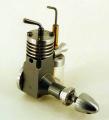 I got the April 1997 issue of Aviation Modeller International in which part one of the construction was featured, and started work on the engine. I discovered some errors around the pitch of the head bolts I think, but it went ok. In the next months issue of the mag there was no follow-up article so I found out who the designer was and made contact with him. He said that in transfering from his sketches to cad drawings for the mag, some errors had been made and he would send me his own sketches. As a result and rather stupidly, I did not buy the second part of the feature, but I think it may have been in June of that year. My engine was in the air before the second part was published.
I got the April 1997 issue of Aviation Modeller International in which part one of the construction was featured, and started work on the engine. I discovered some errors around the pitch of the head bolts I think, but it went ok. In the next months issue of the mag there was no follow-up article so I found out who the designer was and made contact with him. He said that in transfering from his sketches to cad drawings for the mag, some errors had been made and he would send me his own sketches. As a result and rather stupidly, I did not buy the second part of the feature, but I think it may have been in June of that year. My engine was in the air before the second part was published.
If you make one, have a think about lowering the exhaust hole in the case by a little bit, as you will find with the dims given, it wll just break out into the top edge of the case. But don't alter the position of the port in the liner. Just accept that they don't line up, but don't tell anbody! And do not make any of the ports any bigger, they make for a sweet running and very flexible engine. And when end-milling the fransfer ports, don't go too deep or the thin bit of cylinder wall that is left will collapse inwards.
I couldn't resist the temptation, so here's my Midge. To fix the problem Ken noted of the exhaust hole breaking through, I've made a feature of the problem and totally removed metal from the top on down. The case shown here was an experiment: instead of machining it in one piece, it was made as a body with the main bearing glued in (Locktite). It failed as the load bearing length was very short. Second, I made another that was a shrink fit. It failed too showing just how much load a diesel crankshaft is under. The third case (without the Mills-like styling seen here) was made from solid and works just fine, of course. For the engine builders out there, be sure to visit Building the ML Midge which describes the crankcase construction.
 Midges, it appears, tend to multiply! The engine at the rear and to the left was built first. The other (made in for Mr Ray Strinati in partial trade for Yet Another Mountain of Magazines) has two minor changes reflecting leasons learnt from the first. First, the mounting flange is a larger diameter, and second, the venturi tube is a little longer. The first change gives more rigid mounting. The second provides enough space between the fuel tank and the crankcase to insert a mounting bolt and screwdriver without the need to unscrew the fuel tank to gain access! Both are a delight to run. The tank is on the left, not as Ken asserts because all Australians are standing on their heads, but because the arrangement felt more natural to me. I would like to say that I made this choice becauseI tend to hold the model in my right hand and adjust needle valves with my left, but the real reason is I milled the exhaust on the "wrong" side and had no choice in the matter!
Midges, it appears, tend to multiply! The engine at the rear and to the left was built first. The other (made in for Mr Ray Strinati in partial trade for Yet Another Mountain of Magazines) has two minor changes reflecting leasons learnt from the first. First, the mounting flange is a larger diameter, and second, the venturi tube is a little longer. The first change gives more rigid mounting. The second provides enough space between the fuel tank and the crankcase to insert a mounting bolt and screwdriver without the need to unscrew the fuel tank to gain access! Both are a delight to run. The tank is on the left, not as Ken asserts because all Australians are standing on their heads, but because the arrangement felt more natural to me. I would like to say that I made this choice becauseI tend to hold the model in my right hand and adjust needle valves with my left, but the real reason is I milled the exhaust on the "wrong" side and had no choice in the matter!
![]()
